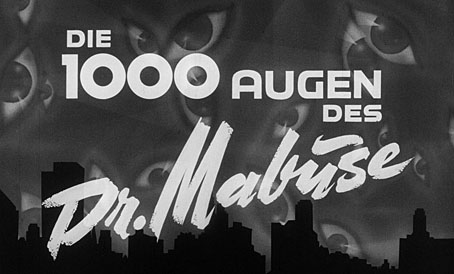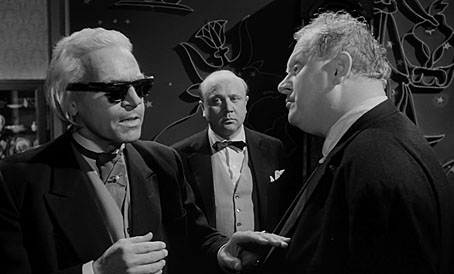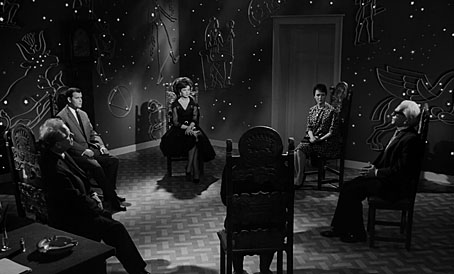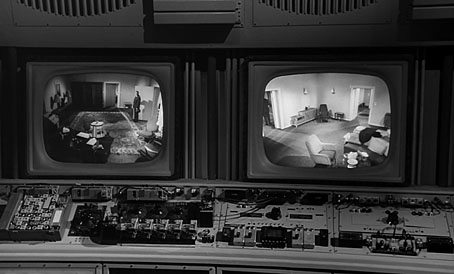Among the weekend’s viewing was the third and final film in Fritz Lang’s Mabuse cycle, The Thousand Eyes of Dr Mabuse (1960). This was also Lang’s final feature, made after his return to Germany in the late 1950s, and another film of his that for many years I knew only as an impossible-to-find title. I’d read about the Mabuse series in Lotte Eisner’s study of Lang’s career even before the name and character was co-opted by Propaganda for their first single in 1984, but the only films of Lang’s that ever used to appear on TV were the Hollywood features or, if you were lucky, a poor print of Metropolis. Mabuse was a source of fascination for the way the character connected the beginning and ends of the director’s career, as well as being a German take on the Moriarty-like super-criminal. The first film in the series, Dr Mabuse, the Gambler (1922), condenses the corruption of Weimar Germany into a potent physical icon, while the sequel, The Testament of Dr Mabuse (1933), reflects the fevered moment when real super-criminals were taking control of the nation. The Nazis were sufficiently discomforted by Testament to ban it shortly after its release.
Cornelius the psychic with insurance salesman Hieronymus B. Mistelzweig and police inspector Kras.
The Thousand Eyes of Dr Mabuse appeared just as new super-villains were emerging to oppose James Bond and his imitators. One of Bond’s early adversaries, Auric Goldfinger, was portrayed on screen by Gert Fröbe who appears here on the opposite side of the law as homicide inspector Kras. Fröbe’s tenacious policeman is one of the few fixed points in a plot filled with twists and deceptive identities. Assassinations and double-crosses are a staple of this type of thriller but Lang also gives us an early example of electronic surveillance in a contemporary setting, together with a séance that harks back to a similar scene in the first Mabuse film. The séance is an unusual touch in a story otherwise devoid of similar moments, prompted by the film’s most mysterious character, Cornelius the blind psychic. With an appearance reminiscent of the late Karl Lagerfeld, Cornelius is an overt throwback to Lang’s pre-war films, many of which hinted at the mystical or supernatural even when such hints seemed unnecessary; Rotwang, the robot-builder in Metropolis (played by the original screen Mabuse, Rudolph Klein-Rogge) is a mechanical genius who just happens to live in a house more suited to an alchemist, with a huge inverted pentagram on one of its walls. The sinister motives of Cornelius aren’t so baldly stated but his consulting room is lavishly decorated with astrological diagrams. The psychic, together with the criminals and the police inspector, create a problem common to films of this kind in which the more colourful characters generate greater interest for the viewer than do the romantic leads. After a succession of breathless opening scenes, Thousand Eyes sags a little while wealthy industrialist Henry Travers (Peter Van Eyck) is getting to know Marion Menil (Dawn Addams), a woman he rescues from a suicide attempt. The film also lacks the subtext of the earlier episodes, although Mabuse’s scheme turns out to be diabolical enough for any of James Bond’s Cold War enemies.
The séance.
If The Thousand Eyes of Dr Mabuse doesn’t quite return Lang to his pre-war UFA heights it’s refreshing to see him working again with this kind of material. One of the odd features of Lang’s Hollywood career is the lack of directorial invention that distinguishes his German films. Many of his Hollywood dramas are superior examples of film noir but without credits they could easily be taken for the work of other noir directors, some of whom (Robert Siodmak, Billy Wilder) were also German émigrés. Lang made two science fiction films while at UFA (Metropolis and Woman in the Moon), together with the mythological epic of Die Nibelungen, but with the exception of Moonfleet and a trio of Westerns his Hollywood career followed the template of the superb M: contemporary dramas that are only generic when they deal with the subject of crime. The pulpier criminality of Thousand Eyes suggests a career that might have taken a different route.
Two of Mabuse’s thousand eyes.
I was watching a new blu-ray release of Thousand Eyes from Eureka which includes an alternative ending that only appeared in French prints. The malevolent Dr Mabuse continued to threaten the world after Lang had finished with him but subsequent films succumbed to franchise fatigue so I don’t think I’ll be seeking them out. Having referred to Goldfinger earlier there’s a minor detail worth mentioning that I’ve not seen noted in reviews: Thousand Eyes climaxes with a car chase during which a group of fleeing criminals hear the plate number of their car being read over the police radio. The driver immediately flips a switch that changes the car plates to a different number, a trick most commonly associated with the Aston Martin DB5 that James Bond drives. The Bond producers chose Gert Fröbe for the Goldfinger role after seeing him in another film but it seems they may have borrowed more than an actor from the German cinema.
Previously on { feuilleton }
• Dr Mabuse posters
• Metropolis!
• A Secret Wish by Propaganda
• Metropolis posters





I adore this film. Lang’s maze-like construction fits the subject matter perfectly.
Thank you for all this lovely pages John. It is a pleasure to read them.
One of the films of Fritz Lang iv’e seen in the cinema. Metropolis, as premiere of the refurbished film and a premiere for the same-named film theater over here in Hamburg.
With one of the last piano players that played as professional in silent movies. I never forget this performance.